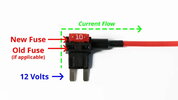joje22
New Member
Hey everyone
I'm hardwiring up my 70mai A800s dashcam for the first time, and I've got a question.
Here's the thing: I read somewhere that the original fuse to be able to handle the new load from the dashcam in addition to its own pulling.
Like, let's say there's a fuse in there that's rated for 15A and I plan to use a fuse tap to hook up a 5A fuse for my dashcam. I'm wondering, what if the original 15A fuse is already close to its limit and I add in a dashcam that pulls maybe 2-3A more? That could push things over the top, right? I assume that I might have misread something and that this is what the new 5A fuse is for, but I'm a bit confused.
Got any advice on this?
I'm hardwiring up my 70mai A800s dashcam for the first time, and I've got a question.
Here's the thing: I read somewhere that the original fuse to be able to handle the new load from the dashcam in addition to its own pulling.
Like, let's say there's a fuse in there that's rated for 15A and I plan to use a fuse tap to hook up a 5A fuse for my dashcam. I'm wondering, what if the original 15A fuse is already close to its limit and I add in a dashcam that pulls maybe 2-3A more? That could push things over the top, right? I assume that I might have misread something and that this is what the new 5A fuse is for, but I'm a bit confused.
Got any advice on this?

